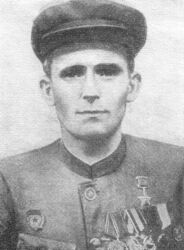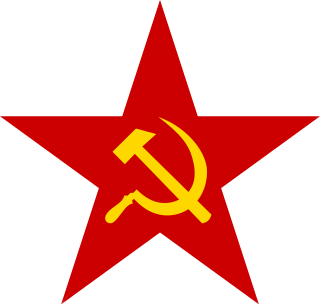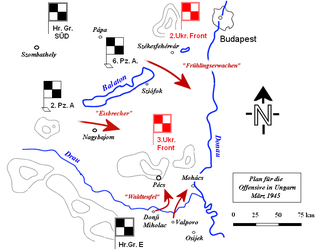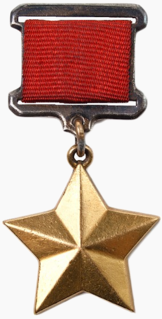Mikhail Grigoryevich Solovyov was a Red Army Lieutenant and posthumous Hero of the Soviet Union. Solovyov was posthumously awarded the title for his leadership of a company during the Battle of the Dnieper, in which he reportedly killed 31 German soldiers. Solovyov was killed in action during the Battle of the Dnieper.
Nikolai Ilyich Usenko was a Red Army man and Hero of the Soviet Union. Usenko was awarded the title on 10 January 1944 for his actions during the Battle of the Dnieper in October 1943. During the battle, Usenko, a telephonist, was reported to have repaired numerous breaks in the line, often under German fire. He was also reported to have killed 25 German soldiers. Later he was seriously wounded and blinded by a German shell and medically retired from the Red Army. He subsequently returned to his home in Krasnoyarsk Krai and worked in the logging industry.
Aleksandr Petrovich Yunev was a Red Army senior lieutenant and Hero of the Soviet Union.Yunev was awarded the title for his actions in Operation Spring Awakening for his part in repulsing numerous German attacks. Postwar, Yunev continued to serve in the army and died in 1952 as a result of his war wounds.

Mikhail Denisenko was a Red Army Major general and Hero of the Soviet Union. He fought in World War II with the Soviet airborne, leading the 36th Guards Rifle Division and 12th Guards Airborne Division. Postwar, Denisenko commanded the 103rd Guards Airborne Division, before his death in 1949 in a parachute accident.

Ivan Prokofievich Afanasenko was a Red Army Sergeant and a Hero of the Soviet Union. Afanasenko was awarded the title Hero of the Soviet Union for reportedly crossing the Danube multiple times under fire between 4 December and 5 December 1944. Postwar, he worked as a tractor driver in Volgograd.

Kadi Abakarovich Abakarov was an Avar Red Army sergeant who fought during World War II. Abakarov was awarded the title Hero of the Soviet Union for actions in the Battle of the Seelow Heights.

Mehmet Aipov was a Tatar Red Army Soldier who fought during World War II. Aipov was posthumously awarded the title Hero of the Soviet Union for actions during the Battle of Berlin, where he reportedly killed 26 German soldiers. Aipov died of his wounds after being seriously wounded in the battle.

Pavel Vasilyevich Mironov was a Red Army lieutenant general and Hero of the Soviet Union. Mironov led the 37th Guards Rifle Corps during World War II.

Pavel Andreyevich Mironov was a Red Army Junior Lieutenant and a posthumous Hero of the Soviet Union. Mironov was awarded the title Hero of the Soviet Union and the Order of Lenin for actions during the Bratislava-Brno Offensive.

Dmitry Fedorovich Loza was a Ukrainian Red Army Colonel and Hero of the Soviet Union. He served as an Armor officer during World War II, fighting in the Vienna Offensive and in the Manchurian Strategic Offensive Operation. Loza was awarded the title Hero of the Soviet Union for his leadership of a tank battalion in the Vienna Offensive. Postwar, he was a senior lecturer at the Frunze Military Academy before retiring from the Soviet Army in 1967.

Pavel Filippovich Lagutin was a Soviet Army Lieutenant general who commanded the 293rd Rifle Division. He led the 293rd through its fighting in the Battle of Stalingrad. For its actions at Stalingrad, the division became the 66th Guards Rifle Division. He continued to command the division until 1944, when he became the deputy commander of the 6th Guards Army.
Viktor Andreyevich Turbin was a Red Army Junior Lieutenant and posthumous Hero of the Soviet Union. Turbin was posthumously awarded the title Hero of the Soviet Union and the Order of Lenin for his actions while leading a platoon during Operation Bagration in summer 1944. His platoon reportedly held a bridgehead on the Drut River against numerically superior German troops until the crossing of the remainder of Turbin's regiment.

Vasily Dmitrievich Myachin was a Soviet Army colonel and a Hero of the Soviet Union. Myachin was awarded the title Hero of the Soviet Union for his leadership of a battalion during the Berlin Offensive. Postwar, Myachin continued to serve in the army, retiring in 1978, after which he worked as an air traffic controller.

Maguba Guseynovna Syrtlanova was a senior lieutenant and deputy squadron commander in the 46th Taman Guards Night Bomber Aviation Regiment during the Second World War. She was awarded the title of Hero of the Soviet Union on 15 May 1946 for having completed 780 sorties during the war.

Yevdokiya Ivanova Nosal was a junior lieutenant and deputy squadron commander in the 588th Night Bomber Regiment during World War II. She was posthumously awarded the title Hero of the Soviet Union on 24 May 1943, making her the first woman pilot to be honored with the title during the war.

Zoya Ivanovna Parfyonova was a senior lieutenant and deputy squadron commander in the 46th Taman Guards Night Bomber Aviation Regiment World War II. After completing 815 sorties during the war she was awarded the title Hero of the Soviet Union on 18 August 1945, making her the only woman from Chuvashia to receive the title.

Lyudmila Kravets was a Senior Sergeant in the 63rd Guards Rifle Regiment in the 23rd Guards Rifle Division of the 3rd Shock Army on the 1st Belorussian Front during World War II. For her actions in the war, she was awarded the title Hero of the Soviet Union on 31 May 1945, and was the only woman in her regiment to be awarded the title.

Mariya Shcherbachenko was a Sergeant in the 835th Rifle Regiment of the 237th Infantry Division in the 40th Army on the Voronezh Front during World War II, referred to by the Soviets as the Great Patriotic War. For being one of the first 13 soldiers to cross the Dnieper she was awarded the title Hero of the Soviet Union on 23 October 1943.

Uzeir Abduramanovich Abduramanov was a sapper in the Red Army during the German-Soviet War. After securing the safe transfer of troops across the Sozh river under heavy enemy fire and through icy water, he was declared a Hero of the Soviet Union on 15 January 1944. Despite having served in the Red Army throughout the entire war and achieving recognition for his bravery, he was still deported to Uzbekistan in 1945 because of his Crimean Tatar ethnicity. His entire family had also suffered exile in the deportation of 1944.

Dasha Ibragimovich Akayev was the first Chechen pilot and a regimental commander in the Soviet Air Forces. He was killed in action leading an attack on a heavily fortified German airfield just three days after the NKVD began the exile of the Chechen people.




























